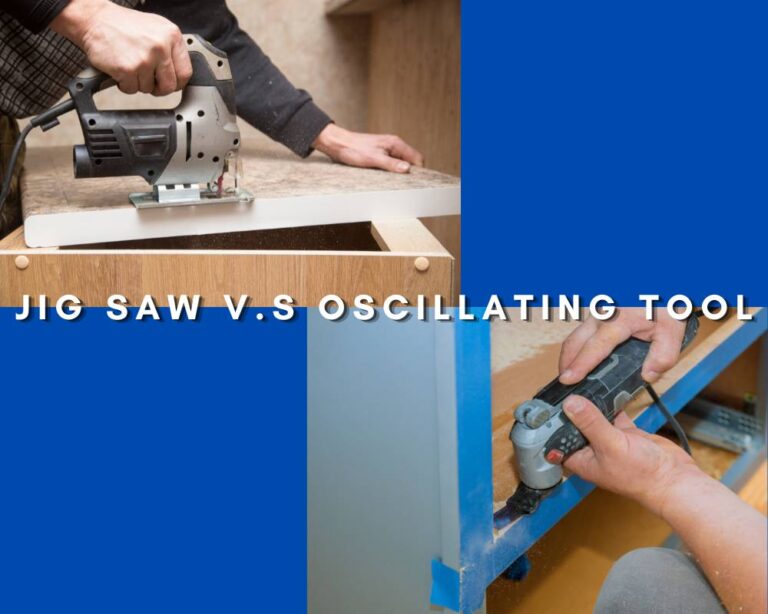Versatility Or Specialization? Orbital Sander Vs Oscillating Tool In Focus
Introduction
In the vast world of power tools, a perpetual debate exists between versatility and specialization. Regarding sanding and cutting, two remarkable contenders grapple for the most efficient and effective tool title: the orbital sander and the oscillating tool.
Each possesses distinct characteristics that make them formidable choices in their own right. This article will delve into these two powerhouses, exploring their unique features and capabilities while examining the merits of versatility versus specialization.
To understand the significance of this debate, it is essential to grasp the fundamentals of power tools. Power tools are mechanical devices designed to facilitate various construction or woodworking tasks with enhanced efficiency and precision.
These technologically advanced instruments have revolutionized traditional manual labour, empowering artisans and hobbyists. Due to its exceptional sanding prowess, the orbital sander is a leading protagonist in woodworking workshops worldwide.
This tool employs a circular motion with an offset axis, ensuring a uniform finish on large surfaces. Its superior ability to eliminate scratches, smoothen rough edges, and create consistent results has earned it a reputation as an indispensable asset for any serious woodworker.
On the other hand, we have the oscillating tool—a multifunctional marvel capable of tackling various tasks with finesse. This versatile dynamo harnesses rapid oscillatory movements to perform precision cutting, grinding, scraping, and sanding across diverse materials such as wood, metal, plastic, or even tile.
Its interchangeable accessories enable users to switch between different functions without requiring additional specialized tools. As we embark on this exploration into orbital sanders versus oscillating tools—versatility pitted against specialization—it is crucial to consider their individual strengths and how they cater to specific requirements within different projects or industries.
Thoroughly examining their features, applications, limitations, and real-world case studies showcasing their performance will enable us to make informed decisions when choosing between these powerful contenders. The following sections will comprehensively analyze the orbital sander and oscillating tool, comparing their capabilities, ergonomics, durability, and overall effectiveness.
By examining both tools under various scenarios and how they fare against each other in head-to-head comparisons, we aim to equip our readers with the knowledge necessary to determine which tool best aligns with their specific needs and aspirations. So let us embark on this enlightening journey into the realm of power tools, facilitating informed decision-making in the eternal quest for superior craftsmanship.
Understanding Power Tools: The Basics
Power tools are fundamental to any handyman or do-it-yourself enthusiast’s toolkit.
These robust and efficient devices increase productivity and precision in various tasks, making them indispensable in many construction, remodelling, and woodworking projects. To fully grasp the world of power tools, it is essential to comprehend their basic components, functions, and classifications.
At their core, power tools are mechanical or electrical devices that facilitate manual labour by utilizing an external power source. They come in various shapes and sizes, each designed to serve a specific purpose.
By harnessing energy from electricity or compressed air, these tools generate the force required to carry out demanding tasks with ease. Regarding functionality, power tools can be broadly classified into two main categories: handheld and stationary.
Handheld tools include portable devices easily maneuvered by hand to perform various tasks precisely. Handheld power tools include drills, saws, sanders, and grinders.
On the other hand, stationary power tools are typically larger machines fixed in place for more robust operations, such as cutting large pieces of lumber or shaping metal. It is crucial to understand their key components to harness the full potential of power tools safely and effectively.
Most power tools consist of a motor that converts electrical or pneumatic energy into mechanical energy necessary for operation. The motor drives a rotating shaft or blade that performs specific actions based on the tool’s intended purpose.
Furthermore, many modern power tools incorporate speed control mechanisms for adjusting operating speeds according to different materials or task requirements. Safety features like blade guards or trigger locks ensure operator protection during use.
By familiarizing ourselves with these fundamental aspects of power tool operation—from basic functionalities to different types—it becomes easier to choose the right tool for specific applications. In subsequent sections, we will delve deeper into two prominent power tools – the orbital sander and oscillating tool – each known for its unique attributes to understand their capabilities better and determine which suits specific tasks most effectively.
Diving into the World of Orbital Sanders
Orbital or finishing sanders are powerful tools designed specifically for sanding and smoothing surfaces.
These versatile machines come in various shapes and sizes, but they all share a common purpose: to deliver exceptional results in surface preparation and finishing tasks. One key feature of orbital sanders is their unique random orbital motion.
Unlike traditional sanders that operate in a linear or circular motion, orbital sanders move in an elliptical pattern. This random orbit allows for more even distribution of sanding action, preventing the formation of unsightly swirl marks or scratches on the workpiece.
Another notable aspect of orbital sanders is their ability to accommodate different abrasives. Whether fine-grit sandpaper for delicate finishing work or coarse-grit discs for rapid material removal, these machines can be easily fitted with the appropriate abrasive pads to suit the task.
Orbital sanders are particularly advantageous when it comes to tackling large surface areas. Their comprehensive coverage and high-speed rotation enable efficient material removal without causing excessive heat buildup or damage to the workpiece.
Moreover, these tools often feature variable speed settings, allowing users to adjust their aggressiveness according to their specific needs. Regarding ergonomics and user-friendliness, orbital sanders have made significant strides.
Many models now feature ergonomic handles with comfortable grips that reduce strain during prolonged use. Additionally, dust collection systems have been integrated into numerous designs, ensuring a cleaner working environment by capturing substantial dust particles generated during operation.
By delving into the world of orbital sanders, one can appreciate their precision and effectiveness in achieving smooth surfaces while minimizing flaws that could mar an impeccable finish. Whether used by professional carpenters or DIY enthusiasts alike, these power tools undoubtedly play a vital role in enhancing project outcomes and saving precious time and effort.
Exploring the Versatility of Oscillating Tools
When it comes to versatility, few power tools can match the capabilities and adaptability of oscillating tools.
These remarkable devices have become a staple in the arsenal of professional contractors and DIY enthusiasts due to their easy handling of a wide array of tasks. One notable aspect of an oscillating tool’s versatility lies in its interchangeable accessories.
Unlike many other power tools designed for specific tasks, oscillating tools accept a variety of attachments, allowing users to switch between cutting, sanding, scraping, grinding, and even polishing applications effortlessly. Whether you need to remove grout from tiles or trim door jambs for a perfect fit during installation, an oscillating tool can meet your diverse requirements without requiring multiple specialized instruments.
Furthermore, oscillating tools excel in tackling intricate and hard-to-reach areas. With their compact design and ergonomic grip, these tools offer excellent maneuverability even in tight spaces such as corners or curved edges.
The oscillating motion of the blade or accessory provides precise control over cutting depths or sanding aggressiveness, making them indispensable when working on delicate surfaces or challenging contours where traditional power tools may struggle. Another facet that emphasizes the versatility of oscillation tools is their ability to work on various materials.
These machines prove highly capable across multiple substrates, from wood and metal to plastics and even drywall. Whether you need to remove rust from metal surfaces or trim excess material from hardwood flooring with utmost precision, an oscillating tool can effortlessly adapt to different materials without compromising efficiency.
One must pay attention to the convenience of cordless oscillating tool versions. With advancements in battery technology allowing for longer run times and rapid charging capabilities, these cordless models offer unparalleled freedom during projects where mobility is vital.
Whether you work outdoors or in locations with limited access to power outlets, a cordless oscillating tool ensures uninterrupted productivity without the constraints of cords. The versatility of oscillating tools is a testament to their unrivalled adaptability and functionality.
With interchangeable accessories, exceptional maneuverability, compatibility with various materials, and the convenience of cordless operation, these power tools have cemented their position as indispensable assets in any professional or DIY enthusiast’s toolbox. From intricate tasks to challenging surfaces, an oscillating tool’s ability to excel in diverse applications is a testament to its remarkable versatility.
Head-to-Head Comparison: Orbital Sander vs Oscillating Tool
When choosing between an orbital sander and an oscillating tool, it’s crucial to understand the critical differences between these two power tools. In this head-to-head comparison, we will delve into their distinct features and functionalities, allowing you to decide based on your specific needs. Let’s start with the orbital sander.
Designed primarily for sanding tasks, this tool boasts a circular sanding pad that moves in a random orbit pattern. The orbital motion ensures that the sandpaper does not stay in one spot for too long, preventing any unwanted marks or grooves on the workpiece.
Orbital sanders are widely appreciated for delivering smooth finishes on wood, metal, and even plastic surfaces. They are handy for large-scale projects like refinishing floors or sanding kitchen cabinets.
On the other hand, oscillating tools offer many functions beyond just sanding. These handheld power tools feature a narrow blade or attachment that moves back and forth at high speeds in an oscillating motion.
This versatility allows them to tackle numerous tasks such as cutting, scraping, grinding, polishing, and even removing grout. Oscillating tools come with interchangeable accessories that can be easily switched out depending on the task.
From cutting through drywall or PVC pipes to removing stubborn adhesives or mortar from tiles – these tools are true workhorses in any toolbox. Both orbital sanders and oscillating tools have their advantages regarding precision and control.
Orbital sanders excel at providing a consistent finish across large surfaces due to their wide circular pad and random orbit pattern, which minimizes swirl marks. Conversely, oscillating tools offer exceptional maneuverability due to their compact size and ability to access tight spaces where larger power tools may struggle.
Regarding dust collection capabilities, orbital sanders often have built-in dust extraction systems or attachable vacuum hoses that significantly reduce airborne particles. This feature keeps the workspace cleaner and promotes better respiratory health.
On the other hand, oscillating tools may not have built-in dust collection systems but can still be used with vacuum attachments for limited dust control. The head-to-head comparison between orbital sanders and oscillating tools reveals their unique strengths and purposes.
While orbital sanders excel in delivering smooth finishes on large surfaces, oscillating tools offer unparalleled versatility for a wide range of tasks beyond just sanding. Consider your specific project requirements and desired functionalities to decide which tool will best suit your needs.
What to Consider When Choosing Between an Orbital Sander and an Oscillating Tool
When faced with the choice between an orbital sander and an oscillating tool, several factors can help you make an informed decision. Each power tool has strengths and limitations, so understanding your needs and requirements is essential. Firstly, assessing the types of projects you will be working on is important.
An orbital sander may be your best bet if you predominantly engage in woodworking tasks such as sanding large surfaces like tables or cabinets. Its circular sanding motion covers a broader area and provides consistent results.
On the other hand, if you often find yourself tackling various tasks involving cutting, scraping, or grout removal in addition to sanding, an oscillating tool might be more suitable. The versatile attachments available for oscillating tools make them adaptable for multiple applications.
Secondly, it is worth considering the precision required for your projects. Orbital sanders excel at providing smooth finishes on flat surfaces but may need more finesse when reaching tight corners or intricate details.
If your work involves intricate woodwork or tight spaces where precision matters, an oscillating tool with its ability to fit into narrow areas and access hard-to-reach spots could be the right choice. Next, take into account the power requirements for your projects.
Orbital sanders typically have higher power ratings than oscillating tools due to their larger size and motor capacity. This makes them better suited for heavy-duty tasks that demand robust performance, such as removing old paint layers or smoothing rough stock quickly and efficiently.
While generally less powerful than orbital sanders, oscillating tools still pack enough punch for most common DIY applications like cutting through drywall or removing grout. Budget considerations play a crucial role in any purchasing decision.
Orbital sanders are generally more affordable than oscillating tools since they have fewer features and attachments in their standard package. However, if you require a tool with multiple functionalities and attachments, an oscillating tool may initially seem more expensive.
Yet, it could save you money in the long run by eliminating the need to purchase separate tools for various tasks. Choosing between an orbital sander and an oscillating tool requires careful consideration of your specific project requirements.
Assessing the types of projects you undertake, the level of precision needed, power requirements, and budget considerations will help guide your decision-making process. Selecting the right tool for the job will significantly enhance your productivity and ensure optimal results.
Case Studies: Orbital Sander and Oscillating Tool in Action
1. Refinishing a Wooden Table: In this case study, we will explore the application of both the orbital sander and the oscillating tool in refinishing a worn-out wooden table.
With its circular motion and random orbit pattern, the orbital sander is perfect for large, flat surfaces. It effortlessly removes old finishes or paint layers, revealing the beautiful grain beneath.
Its powerful motor ensures efficient material removal while minimizing swirl marks. On the other hand, the oscillating tool shines when it comes to intricate detail work, such as sanding small crevices or edges that are difficult to reach with a traditional sander.
Its versatile assortment of attachments allows for precise control and meticulous sanding around corners and curves. 2. Tackling Tile Grout Removal:
Let’s delve into another case study involving tile grout removal to highlight how both tools handle this task differently. An oscillating tool equipped with a carbide grout removal blade proves invaluable when removing grout from tiled surfaces.
Its high-frequency oscillations allow for precise cutting without damaging adjacent tiles. The orbital sander may not be the go-to choice for this task since it requires more precision for delicate tile work.
However, you are dealing with larger areas where regrouting is necessary after the complete removal of old grout lines. In that case, the orbital sander can create a smooth surface ready for new grout application. 3. Sculpting Wood Figures:
For our third case study, we will examine how these two tools fare in sculpting wood figures—a popular endeavour among woodworking enthusiasts and artists alike. Here specialization takes centre stage: an oscillating tool fitted with a small saw blade or carving attachment provides unparalleled control when shaping intricate details on wooden sculptures or figurines.
4. The orbital sander is better suited for larger-scale shaping or smoothing tasks, such as creating rounded edges or sanding down larger surfaces. Its random orbital motion ensures a consistent and smooth finish, allowing the wood’s natural grain to shine through.
In this case, the choice between the two tools ultimately depends on the scale of your project and the level of detail required. Examining these case studies shows that the orbital sander and oscillating tool have their respective strengths when applied in specific scenarios.
The orbital sander excels in large-scale projects where speed and efficiency are key factors, while the oscillating tool shines in intricate work that demands precision and versatility. Ultimately, understanding the nature of your task and assessing which tool aligns best with your requirements will help you achieve optimal results in any woodworking or DIY project.
Final Thoughts: Choosing Between Specialization and Versatility
When it comes to choosing between specialization and versatility in power tools, it ultimately depends on the specific needs and preferences of the user. The orbital sander and oscillating tool have unique strengths, allowing them to excel in different tasks.
Understanding your requirements and priorities will guide you towards making an informed decision. On the one hand, specialization might be the key if you primarily work on projects that demand precision and finesse, such as furniture refinishing or intricate woodworking.
The orbital sander’s ability to produce a smooth, swirl-free finish is unmatched. Its circular sanding motion and fine-grit sandpaper ensure exceptional results on delicate surfaces without risking damage or over-sanding.
On the other hand, versatility becomes crucial if your work involves a wide range of applications that extend beyond sanding alone – such as cutting, scraping, or grinding. This is where the oscillating tool truly shines.
With its many interchangeable attachments like cutting blades, scrapers, grinders, and even grout removers, it is a jack-of-all-trades capable of tackling various tasks with ease. Whether renovating your home or working on DIY projects around the house, having a single tool that can handle multiple functions brings convenience and efficiency.
However, it’s essential to consider immediate needs and future projects you may undertake. If you anticipate frequently using different tools for specialized tasks down the line but currently require versatility for diverse applications in various projects simultaneously, investing in both an orbital sander and an oscillating tool might be worth considering.
While this requires more upfront investment in cost and storage space requirements for multiple tools (as well as their accompanying accessories), it provides flexibility no matter which project comes your way. Ultimately, finding a balance between specialization and versatility is possible by carefully assessing your current requirements while keeping prospects in mind.
Whether you prioritize achieving precise finishes or need a tool that can handle many tasks, the orbital sander and oscillating tool have their place in your workshop. By understanding the strengths and limitations of each, you can make an informed decision that aligns with your specific needs, ensuring the efficiency and success of your projects.
Conclusion
This detailed exploration of the orbital sander and oscillating tool shows that both tools possess unique strengths and cater to different needs. The orbital sander provides smooth, consistent sanding results on large, flat surfaces, making it an ideal choice for furniture refinishing or preparing wooden floors for finishing.
On the other hand, the oscillating tool’s versatility shines through its ability to perform various tasks with precision and efficiency, including cutting, scraping, sanding in tight spaces, or tackling intricate detailing work. When it comes to choosing between specialization and versatility, it ultimately depends on one’s specific requirements.
Investing in an orbital sander would be a prudent choice if a project demands a high level of finesse on large surfaces or demands extensive sanding work. This specialized tool provides dedicated results unmatched by any other power tool regarding consistency and precision.
However, an oscillating tool proves itself as the ultimate companion for those seeking a more multifunctional option capable of adapting to diverse tasks within a project scope or requiring access to tight corners and awkward angles where manual labour falls short. With its interchangeable accessories and adaptability across different materials like wood, metal, tile or plastic, this versatile powerhouse offers unparalleled flexibility.
The decision between specialization and versatility ultimately boils down to personal preference and the nature of the project. Whether you choose the precision-driven path of an orbital sander or embrace the adaptability offered by an oscillating tool largely depends on your unique needs.
Power tools are invaluable assets in any DIY enthusiast’s toolbox. While specialization allows for unparalleled expertise in specific applications, like sanding larger surfaces flawlessly with an orbital sander, the versatility offered by an oscillating tool opens doors to endless possibilities when tackling multi-faceted projects with ease.
Embrace these remarkable tools’ potential while considering your requirements – finesse or adaptability. Remember, with the right tool, and you can transform your visions into reality, sparking creativity and achieving remarkable results.





